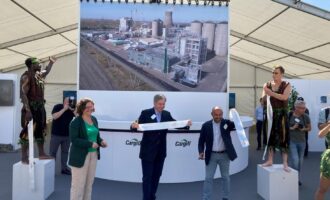
bp to take lead in developing world’s largest renewables hub
bp has agreed to acquire a 40.5% equity stake in and to become operator of the Asian Renewable Energy Hub (AREH) in Pilbara, Western Australia, which has the potential to become one of the largest renewables and green hydrogen hubs in the world.
Based on the development of world-scale renewable power generation, the Asian Renewable Energy Hub intends to supply renewable power to local customers in the largest mining region in the world and also produce green hydrogen and green ammonia for the domestic Australian market and export to major international users.
AREH has plans to develop onshore wind and solar power generation in multiple phases to a total generating capacity of up to 26 gigawatts (GW) – the equivalent of producing more than 90 terawatt hours per year, which is around a third of all electricity generated in Australia in 2020.
At full capacity, AREH is expected to be capable of producing around 1.6 million tonnes of green hydrogen or 9 million tonnes of green ammonia, per annum. Situated on a 6,500-square kilometre site, AREH is already in a highly advantaged position with access to abundant solar and wind resources with consistent output.
Pilbara is a globally competitive and energy intensive mining region with substantial energy demand and carbon emissions. At full capacity, AREH is expected to abate around 17 million tonnes of carbon in domestic and export markets annually, which would equate to roughly 0.5 gigatonnes (Gt) of carbon savings over the lifetime of the project.
“AREH is set to be one of the largest renewable and green hydrogen energy hubs in the world and can make a significant contribution to Australia and the wider Asia Pacific region’s energy transition,” said Anja-Isabel Dotzenrath, bp’s executive vice president of gas and low carbon energy. “It truly reflects what integrated energy is – combining solar and onshore wind power with hydrogen production and using it to help transform sectors and regions. It also reflects our belief that Australia has the potential to be a powerhouse in the global energy transition, benefitting from both its existing infrastructure and abundant renewable energy resources.”
“We believe AREH can be a cornerstone project for us in helping our local and global customers and partners in meeting their net zero and energy commitments. It will also serve as a long-term clean energy security contributor in the Asia Pacific, helping countries such as South Korea and Japan to decarbonise.”
When fully developed, AREH could provide significant net renewable generating capacity for bp as well as making a material contribution to its strategic aim to capture a 10 per cent share in core hydrogen markets globally.
“This is an incredibly exciting development, and we are looking forward to working closely with our partners, InterContinental Energy, CWP Global, Macquarie Capital and Macquarie’s Green Investment Group, as well as the Nyangumarta people,” said Frédéric Baudry, president, bp Australia. “bp brings a broad range of capabilities to help bring the project to fruition, with extensive experience in constructing and operating facilities of this scale in remote locations in close collaboration with local communities and leveraging our global shipping and trading businesses. We also have the benefit of deep experience in working with customers looking for decarbonization solutions and delivering low carbon energy to the global market.”
First proposed in 2014, the AREH project has been developed to date by partners that currently comprise InterContinental Energy, CWP Global and Macquarie Capital and Macquarie’s Green Investment Group.
Under the terms of agreement, bp will acquire a 40.5% interest in the project and will take over its operations from July 1, 2022, subject to approvals. The other partner shareholders in AREH will continue to be InterContinental Energy (26.4%), CWP Global (17.8%) and Macquarie Capital and Macquarie’s Green Investment Group (15.3%).









